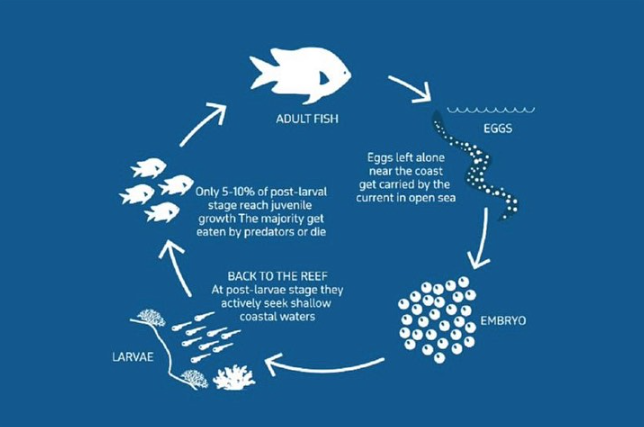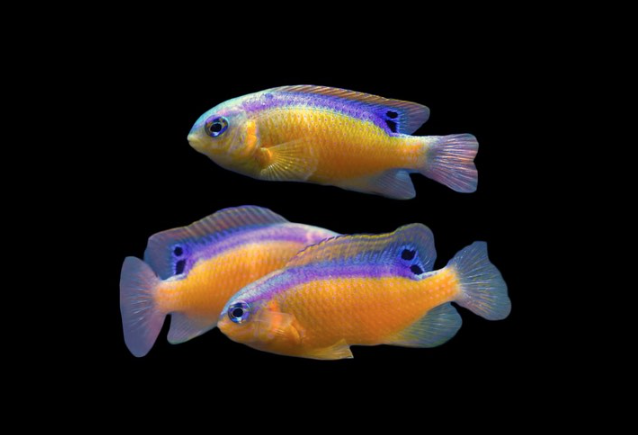In the last week, our social media feed lit up with a new term that describes a different way to collect saltwater aquarium fish – Ranching. Spearheaded by Quality Marine in the US and Tropical Marine Centre in the UK, ranching involves collecting tiny post-larval tropical marine fish at night by way of surface light traps, then rearing the tiny juveniles in captivity for two months until they are larger and can be offered for sale. Although the term was new to us, the practice isn’t as it’s been talked about for most of the twenty years that we’ve been in the industry and has been pioneered and developed by QM and TMC’s eco partner in all this – Ecocean – for some 10 years. So how does it differ from normal saltwater fish collection?
When their eggs hatch, the majority of reef fishes go through a pelagic larval phase, where the larvae drift through the oceans, sometimes for hundreds of miles, dining on phytoplankton and themselves becoming part of the vast zooplankton soup which helps drive the web of life. When they reach the post-larval phase they smell out reefs and habitats, head into shallower water, and seek to settle there, grow on, and become established adults themselves. Mortality is high in this key development stage however, with only 5-10% of post-larval fish surviving predation and territorial attack from congeners, and a less than 1% survival rate if the reef has been damaged or replaced entirely with man-made structures like ports.
Ecocean
This natural attrition of larval fish spelled an opportunity for ecological restoration organization Ecocean however, who developed techniques to collect post-larval fish and grow them in land-based facilities. These Ranched fish demonstrate an 80% survival rate in captivity – 8-16 times that of their wild counterparts, meaning the aquarium trade could be supplied on the one hand, with a huge excess of stronger, larger fish to be re-released onto reefs and artificial habitats in the wild, actually boosting fish numbers as well the process repeating itself over and over, and natural fish numbers growing exponentially at the same time. It’s a win-win for reef conservation and the aquarium hobby, but what’s the catch?
43 species have been collected and successfully ranched to date, although most of the ranched fish for sale right now are Damselfish from the family Pomacentridae. This, says TMC’s CEO Brian Schaff, is to be expected, as the vast majority of reef species you see on a reef, are damsels. The three other prominent fish families caught included Surgeonfish, Filefish, and Pufferfish, but we guess you never know what you’re going to catch, from undesirable juvenile Trevally, to possible new species.

The fish are sorted at collection source and then grown on there, or flown to grow-on facilities at QM and TMC where they are at a saleable size after two months. The collaboration aims to put two fish back for every three it collects, and those ranched fish will go on to repopulate impoverished reefs around the world, which is exciting. Ecocean has also developed artificial habitats to be placed in areas such as ports, which will serve as added refuges for both post-larval and ranched fish, where previously they had less than a 1% survival rate there. Conservation and the aquarium trade working hand in hand, and both benefitting. Who would have thought it?
So will we ever see Ranched Anthias, Fairy Wrasses, and Firefish? According to the scientific paper that Quality Marine points us to, the field studies were conducted in the Mexican Caribbean, so the fish species available will reflect that. Plus young damselfish have always been easy to raise versus other species. But if ranching can be refined and rolled out more widely, if a fish species has a post-larval phase and can be caught by light trap and reared successfully in captivity on aquarium diets, it’s game on! Check out the two videos, and Quality Marine’s info page, to find out more.
Have your say on Ranching over on our Facebook Page.
Main image Surge damselfish, Chrysiptera brownriggii, Copyright Quality Marine.



